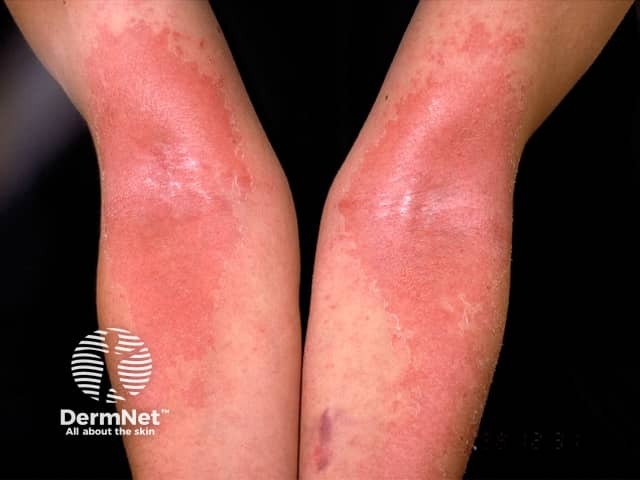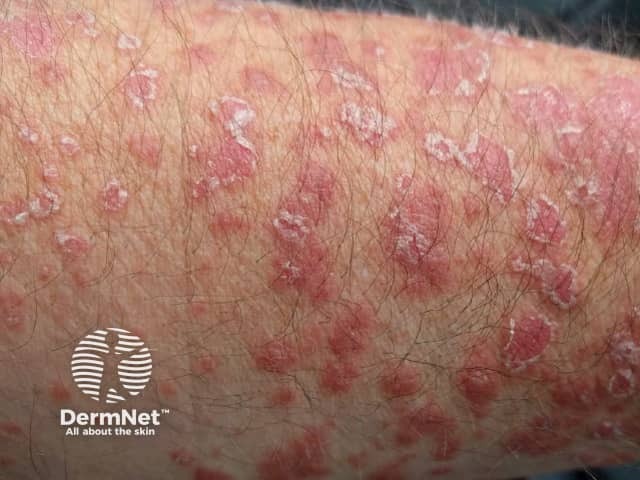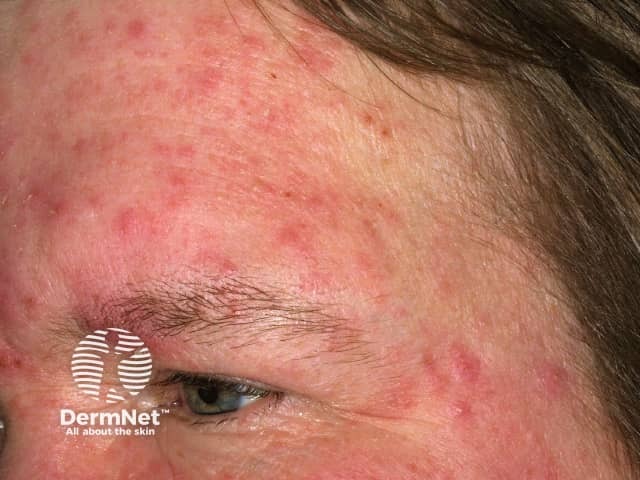Main menu
Common skin conditions

NEWS
Join DermNet PRO
Read more
Quick links
Antimicrobial peptides — extra information
Antimicrobial peptides
Author: Dr Jennifer Taylor, Dermatology Registrar, Waikato Hospital, Hamilton, New Zealand. DermNet Editor in Chief: Hon A/Prof Amanda Oakley, Dermatologist, Hamilton, New Zealand. Copy editor: Maria McGivern. April 2017.
Introduction Where are they found? Function Role in atopic dermatitis Role in psoriasis Role in rosacea Therapeutic potential
What are antimicrobial peptides?
Antimicrobial peptides are protein molecules of the innate immune system and are found in all organisms. They have potent broad-spectrum antimicrobial properties and help protect the body against infection.
There are over 100 antimicrobial peptides in the skin. The best characterised are:
- Cathelicidins
- Defensins.
Cathelicidins were the first AMPs discovered and are abundantly expressed in mast cells. The only human cathelicidin is LL-37 and is also known as cathelicidin antimicrobial peptide 18 kDa or CAP-18.
α-Defensins and β-defensins are widely distributed in epithelial cells and phagocytes in high concentrations.
The role of antimicrobial peptides in atopic dermatitis, psoriasis, rosacea and other skin disorders is under investigation.
Skin diseases where antimicrobial peptides are important

Atopic dermatitis

Psoriasis

Rosacea
Where are antimicrobial peptides found?
Antimicrobial peptides are found in a variety of tissues throughout the body. In the skin, antimicrobial peptides are mainly produced by:
- Keratinocytes
- Sebocytes
- Sweat glands.
They are stored in lamellar bodies (secretory granules found within the layers of cells in the skin). Circulating immune cells, particularly neutrophils, also produce antimicrobial peptides.
- Antimicrobial peptide production is induced by growth factors and circulating immune cells.
- Some antimicrobial peptides are resident in normal, healthy skin.
- The amount of a particular antimicrobial peptide varies with the level of protection required. For example, higher concentrations of the antimicrobial peptide, psoriasin (also known as S100 calcium-binding protein A7 or S100A7), are found on the hands, feet, armpits, and scalp.
- Other antimicrobial peptides (eg, LL-37) are triggered into action by cutaneous injury, infection or inflammation.
What is the function of antimicrobial peptides?
Functions of antimicrobial peptides include:
- Antimicrobial action — antibacterial (fighting Gram-positive and Gram-negative bacteria), antiviral and antifungal action
- Immunomodulatory effects — the recruitment of immune cells to sites of infection or injury
- Wound healing — the formation of new blood vessels and skin at sites of injury
- Cell apoptosis — killing pathogens
- Anticancer activity.
What is the role of antimicrobial peptides in atopic dermatitis?
Patients with atopic dermatitis (eczema) have decreased levels of antimicrobial peptides in their skin. Patients with atopic dermatitis are susceptible to:
- Recurrent bacterial skin infections and colonisation with Staphylococcus aureus
- Viral skin infections, such as herpes simplex, coxsackievirus and molluscum contagiosum.
What is the role of antimicrobial peptides in psoriasis?
There are increased levels of antimicrobial peptides in psoriasis plaques.
- Bacterial infection is uncommon in psoriasis, despite significant barrier disruption.
- Antimicrobial peptides, such as β-defensin 2, may have a role in the pathogenesis of psoriasis. They are thought to form complexes with self-DNA, activating the immune system and causing inflammation.
- Sunlight induces antimicrobial peptides in the skin via the vitamin D pathway. This may contribute to an improvement in psoriasis in summer.
What is the role of antimicrobial peptides in rosacea?
Rosacea is characterised by inflammation and vascular reactivity.
- The cathelicidin LL-37 is usually broken down into small peptides with more antimicrobial and less inflammatory effects.
- In rosacea, abnormal processing leads to higher levels of LL-37 and subsequent inflammation.
What is the therapeutic potential of antimicrobial peptides?
Understanding the molecular elements of antimicrobial peptides might lead to a better understanding of inflammatory skin disease and new treatments.
New antimicrobial agents
Antimicrobial peptides:
- Have broad spectrum and selective antibacterial, antiviral and antifungal activity
- Are non-toxic to host cells
- Are highly conserved (ie, antimicrobial peptide genes are found in multiple animal and plant species through geological time).
- Vitamin D3 and enhanced antimicrobial peptide production on exposure to ultraviolet radiation could reduce infection and restore barrier function in atopic dermatitis.
- Blocking abnormal antimicrobial peptide formation and/or processing could lead to novel treatments for rosacea.
- Inhibiting antimicrobial peptide complex formation could reduce immune activation in psoriasis.
Cancer treatments
The anticancer properties of antimicrobial peptides are currently not well characterised, but there is speculation that antimicrobial peptides could lead to new treatments in the future.
References
- Schauber J, Gallo R. Antimicrobial peptides and the skin immune defense system. J Allergy Clin Immunol 2008; 122: 261–6. DOI: 10.1016/j.jaci.2008.03.027. PubMed Central
- Ong PY, Ohtake T, Brandt C, et al. Endogenous antimicrobial peptides and skin infections in atopic dermatitis. N Engl J Med 2002; 347: 1151–60. DOI: 10.1056/NEJMoa021481. Journal
- Morizane S, Gallo R. Antimicrobial peptides in the pathogenesis of psoriasis. J Dermatol 2012; 39: 225–30. DOI: 10.1111/j.1346-8138.2011.01483.x. PubMed Central
- Johnston RB. An overview of the innate system: Interaction of innate and acquired immunity. UpToDate. Updated 24 May 2016. Available at: www.uptodate.com/contents/an-overview-of-the-innate-immune-system (accessed 23 October 2016).
- De Smet K, Contreras R. Review Human antimicrobial peptides: defensins, cathelicidins and histatins. Biotechnol Lett 2005; 27: 1337–47. PubMed.
- Takahashi T, Gallo R. The critical and multifunctional roles of antimicrobial peptides in dermatology. Dermatol Clin 2017; 35: 39–50. DOI: 10.1016/j.det.2016.07.006. PubMed.
On DermNet
- Atopic dermatitis
- Barrier function in atopic dermatitis
- Psoriasis
- Rosacea
- Wound healing
- Microorganisms found on the skin
- Ultraviolet radiation
Other websites
- Medscape
